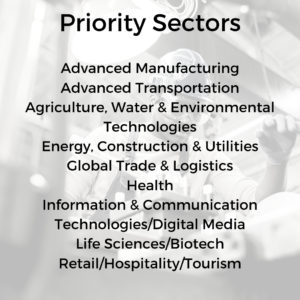The search for skilled labor is an enduring one, especially in the so-called “middle skills” jobs that require an education beyond high school but not necessarily a four-year degree. It is the largest segment of the labor market in the United States. There is a high demand for workers in traditional industries like construction and manufacturing, as well as growing industries like health care, information technology, transportation and logistics, and energy.
In California, to create the pipeline of workers to fill these jobs, businesses are turning to the state’s community colleges and a growing apprenticeship program targeting these high-growth industries.
Round two: More programs, more industries
The California Community College’s Board of Governors recently awarded $10 million in grants to establish new apprenticeship programs aimed at meeting local labor needs. The grants are expected to fund programs at the college system’s 115 schools, training at least 500 new apprentices.
In 2016, 70 percent of California’s registered apprenticeships were in the construction field, even though it employed only five percent of the state’s workforce. In contrast, less than one percent of apprenticeships were in manufacturing, transportation, and health care combined, even though roughly 18 percent of the state’s workers were employed in those industries.
Growing diversity
Diversity also was an issue with women making up just six percent of the state’s apprentices.
To help remedy these disparities, California’s governor and the state Legislature created the California Apprenticeship Initiative (CAI) grant program. Between 2016 and 2018, it awarded 40 grants totaling $27.5 million to community colleges, school districts, and their partners to create new apprenticeship programs in industries where apprenticeships were lacking.

The result was an increase in apprenticeships in advanced manufacturing, transportation and logistics, hospitality, and the culinary arts. There also was a dramatic increase in the number of women (27 percent) in apprenticeship programs during the first round of grants. This is expected to continue because of the focus on occupations that have a greater gender balance.
A majority of apprentices who took part in the CAI programs found them to be very helpful (61 percent) or helpful (21 percent) in preparing them to work in their chosen occupations. While employers reported their apprentices were more knowledgeable about their occupations and more prepared to learn than past interns they had hired.
Expanding the apprenticeship fields
California presently has 94,000 registered apprentices with the goal of increasing that to 500,000 by 2029.
“The goal really is to expand apprenticeship programs in new and innovative occupations outside of the building trades,” according to Nick Esquivel, Specialist in Workforce and Economic Development with the California Community Colleges chancellor’s office. “So that’s creating new apprenticeship programs from the ground up and then also creating pipelines through pre-apprenticeship programs into existing building trades programs as well as into these new and innovative programs.”
Good for the worker, good for the employer
Apprenticeships are gaining more attention these days because they benefit both the employer — who gain skilled workers at the end of training — and the workers — who get to earn while they learn.
Esquivel tells WorkingNation, “It’s a custom-catered kind of human resource approach to workforce development where the apprentice is supervised by a journey person in the respective occupation. So, the minimum on-the-job training hours each year is about 2,000. So, an apprentice is going to be working with that for 2,000 hours of on-the-job training. They’re paid from day one, and then there’s the 144 class hours a year. This provides a kind of an ideal training model for employers because they’re developing the training in collaboration with the joint apprenticeship training committee.”
For the student, the entire program is tuition and fee free, with those costs being subsidized by the state.
“The end goal is that the apprentice completes the term of their respective apprenticeship programs,” Esquivel says. “So, for an LVN to an RN apprentice, that can be a four or five-year journey, but once they complete that, that current registered nurse is now able to make a six-figure salary working in any one of our California state hospitals or California state prisons. If it’s a carpenter, a plumber or a pipefitter, they’re automatically going to be in a middle-skill, middle-wage job eligible to work throughout the state. We touch so many different occupations that the success stories are really endless.”
Customized apprenticeships

California’s community college system has sought to let industries work with individual schools to shape the apprenticeship program, as opposed to the historical model which was based primarily in the labor unions. This provides the opportunity to customize the apprenticeships to better suit the needs of business and the apprentices, according to Jose Anaya, Dean of Community Advancement at El Camino College. Anaya oversees the school’s current manufacturing apprenticeships at Northrup Grumman.
“We have, through this creative model, the ability to really customize how we do things. But what we’ve decided to do is we want to give students college credit,” Anaya tells WorkingNation. “What we’ve done is we’ve kind of mapped out the different classes that they could take as part of their apprenticeship program so they can continue their education and earn a certificate or an associate’s degree. And so that’s how we crafted it because we really want students to have that opportunity to continue their education if they so desire. Other apprentices in the state, their RSI could be done differently. We’ve all been kind of given the leeway to put it together any way we see that makes sense.”
This flexibility allows businesses to better shape the apprentice for the work environment they are entering.
“What we bring to the table is an opportunity for us to bring our students and partner with an employer to basically groom that individual through an apprenticeship program to that skill level that they want. It’s an opportunity for them to develop their workforce through this apprenticeship model. And it’s an opportunity for our students to kind of earn and learn. The idea is over the course of two to four years, depending on the length of the apprenticeship, and again, we customize it for the employer. And so, over the course of two to four years, we groomed this individual to that skill level that they want.”
One element El Camino has put in place to help companies ease into an apprentice program and to determine which students are right for an apprenticeship is an eight-week summer program called a co-op.
“Basically, that co-op is a two-unit course. Students come to work at Northrop Grumman and they go to a structured curriculum where they actually are exposed to kind of the work that Northrop Grumman does,” Anaya says. “Not only are the students exposed to the work, but Northrop Grumman is exposed to the students. Northrop Grumman calls it an eight-week interview because the students are checking out Northrop Grumman, Northrup Grumman is checking out the students. And after the eight-week co-op, Northrop Grumman extends an offer to those students that they want to bring into an apprenticeship program.”
“Some employers really liked the co-op model because they get to experience the students and figure out if it’s a good fit for the student and for the employer and other companies we’re talking to just want to hire the students right away and then that’s fine too. So again, it’s that creative model that we customize each program to fit the needs of the employer.”
Related Articles:
The first fully-online state community college will serve “stranded workers”
Discovering the value of work-based learning opportunities
Go for an apprenticeship and get paid to learn a new trade
New study: Increasing apprenticeships will lead to more companies saying “you’re hired!”











